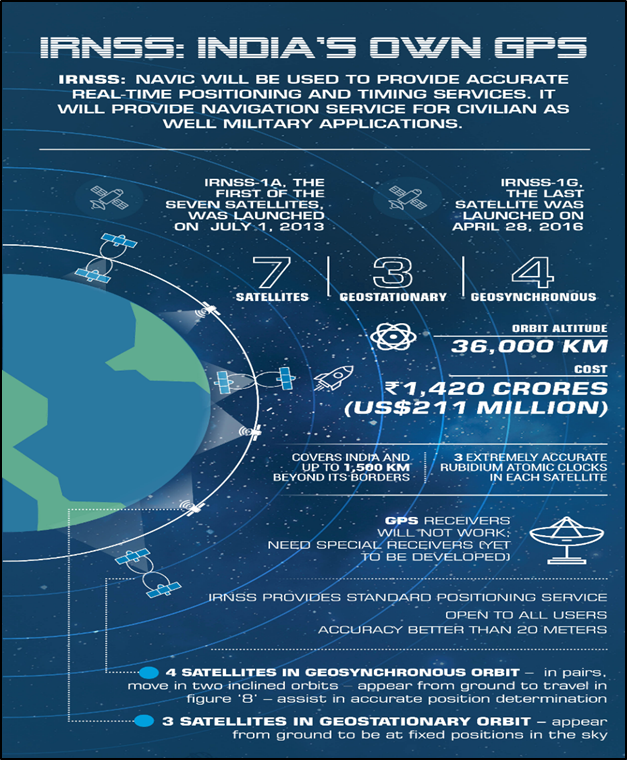In News:
- On the side-lines of the India Space Congress, the Indian Space Research Organisation (ISRO) recently revealed its plans to expand the reach of NavIC (Navigation with Indian Constellation) beyond India and not to a limited territory around India.
- ISRO is also working on a series of NavIC improvements to encourage more people to install and use it.
What’s in today’s article:
NavIC (Navigation with Indian Constellation):

- NavIC, also known as the Indian Regional Navigation Satellite System (IRNSS), is an independent stand-alone indigenous navigation satellite system developed by the Indian Space Research Organisation (ISRO).
- NAVIC was approved in 2006 and was expected to be completed by 2011, but only become operational in 2018.
- NavIC, which consists of 7 satellites, covering the whole of India's landmass and up to 1,500 km from its boundaries, is conceived with the aim of removing dependence on foreign satellite systems for navigation, particularly for "strategic sectors.".
- Currently, NavIC's application in India is limited in -
- Public vehicle tracking,
- For providing emergency warning alerts to fishermen venturing into the deep sea where there is no terrestrial network connectivity and
- For tracking and providing information related to natural disasters.
- The next step India is pushing for is to include it in smartphones.
- According to India's draft satellite navigation policy 2021, the government will work toward "expanding the coverage from regional to global" to ensure the availability of NavIC signals in any part of the world.
Competitors:
- GPS: The main difference between GPS (caters to users across the globe and its satellites circle the earth twice a day) and NavIC (currently for use in India and adjacent areas) is the serviceable area covered by these systems.
- Others:
- Like GPS, there are three more navigation systems that have global coverage - Galileo from the European Union, Russia-owned GLONASS and China's Beidou.
- QZSS, operated by Japan, is another regional navigation system covering the Asia-Oceania region, with a focus on Japan.
News Summary:
India Space Congress (ISC) 2022:
- The SatCom Industry Association (SIAIndia) is organising a three-day ISC 2022 in New Delhi.
- The theme of ISC 2022 is ‘Leveraging Space to Power Next-Gen Communication & Businesses’.
- ISC 2022 is supported by the ISRO, Ministry of Defence, Niti Aayog, In-Space, NewSpace India Ltd (NSIL) and the Department of Telecommunication.
- To foster the growing interest in deep space tech startups in India, ISC 2022 announced a number of initiatives to showcase excellence.
- By engaging with 'iDEX 75 Space Challenges' which was announced by PM Modi during the Defence Expo, Microsoft will extend Founders Hub benefits to the 15 shortlisted startups.
- As part of the Founders Hub program, Microsoft provides founders with free resources to help overcome the challenges startups face.
The NavIC will undergo following significant changes in the near future:
- Adding the L1 band into NavIC: Currently NavIC is only compatible with the L5 and S bands and hasn’t easily penetrated into the civilian sector.
- L1 bandwidth is part of the GPS and is the most used for civilian navigational use.
- Increasing the safety of the signals: There are two types of codes - Long Code and Short Code. NavIC currently only offers short codes. This must become Long Code for the strategic sector's use, to prevent the signal from being compromised.
- 5 new satellites to replace decommissioned NavIC satellites: To be launched in the coming months, the new launches (medium earth orbit (MEO) satellites) will make NavIC truly “global” like GPS.
- Currently, NavIC satellites orbit earth in a geostationary or geosynchronous (GEO) orbit, about 36,000 km from earth.
- MEO orbits occupy a space between GEO and Low Earth Orbit (LEO).










